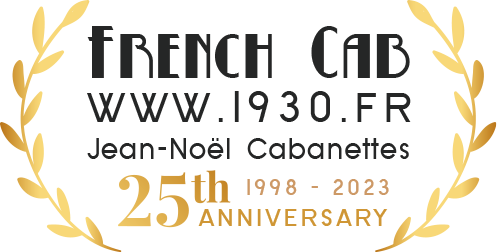Paul Emile brandt lacquer and eggshell box.
An extremely hard to find lacquer and eggshell box attributed to Paul Brandt.
Not sure about metal. Silver gilt ? Just a maker hallmark. (pls see pictures)
Unsigned, as often for Paul Brandt boxes.
But pattern and colors are typical of this artist.
12cm 9cm 1.2cm
Excellent condition. Nothing wrong.
Circa 1930.
Brandt, Paul Emile
1883-1952
1883 Paul-Emile Brandt was born in Chaux-Fonds, Switzerland . At a young age, he moved to Paris where he studied with Chaplain and Allard and received a solid foundation in several disciplines including jewellery design, painting, sculpture, engraving, and enamelling. 1906 -1911 In the first decade of the twentieth century, he went into his own business. He created jewellery in the Art Nouveau style which he exhibited in the annual expositions of 'La Societe des Artistes Francais’ in 1906. Some of his pieces were acquired by the Musée des Artes Décoratifs in Paris. 1921 Experiments with engraving precious stones 1923 Brandt’s window at the Salon des Artistes Français reads ‘Jewellery, Jewellery and engraved stones, precious stones, platinum and gold’ 1925 Participated in the International Exhibition where he exhibited Art Deco style ‘jewellery of great design, and great construction’ 1926 Brandt’s participation in the fairs intensifies. This year he produces brooches pave set with brilliants, with calibre-emeralds and in a very distinctive art deco style. His pieces are very geometric in design, with abstract compositions and using enamel and lacquer. He displayed numerous cigarette cases decorated in lacquer with circles as the dominant motifs. 1927 Brandt accorded huge importance to the display of his jewellery. He employed architect Eric Bagge to design and construct the window for his Salon. The design echoed the simple geometric forms of Brandt’s jewellery. Like Jean Després and Raymond Templier, Brandt began experimenting with the effect of light and juxtaposing plaques of lapis lazuli or lacquer with transparent materials like rock crystal or diamonds. He also used delicate round pearls as a contrast to the regular lapis forms. 1930 – 31 Brandt creates rings, pendants and bracelets that combine geometric figures with sections of work in relief. 1936 The last year that Brandt exhibited at the Salons, he began to turn his attentions towards more industrial pursuits.
He opened a tin factory with fifteen to twenty workers situated in rue de Tlemcen which helped with the war effort between 1939 and 1945 1939 – 1945 Second World War 1952 Brandt died in Paris 1953 Brandt’s factory closed down
Not sure about metal. Silver gilt ? Just a maker hallmark. (pls see pictures)
Unsigned, as often for Paul Brandt boxes.
But pattern and colors are typical of this artist.
12cm 9cm 1.2cm
Excellent condition. Nothing wrong.
Circa 1930.
Brandt, Paul Emile
1883-1952
1883 Paul-Emile Brandt was born in Chaux-Fonds, Switzerland . At a young age, he moved to Paris where he studied with Chaplain and Allard and received a solid foundation in several disciplines including jewellery design, painting, sculpture, engraving, and enamelling. 1906 -1911 In the first decade of the twentieth century, he went into his own business. He created jewellery in the Art Nouveau style which he exhibited in the annual expositions of 'La Societe des Artistes Francais’ in 1906. Some of his pieces were acquired by the Musée des Artes Décoratifs in Paris. 1921 Experiments with engraving precious stones 1923 Brandt’s window at the Salon des Artistes Français reads ‘Jewellery, Jewellery and engraved stones, precious stones, platinum and gold’ 1925 Participated in the International Exhibition where he exhibited Art Deco style ‘jewellery of great design, and great construction’ 1926 Brandt’s participation in the fairs intensifies. This year he produces brooches pave set with brilliants, with calibre-emeralds and in a very distinctive art deco style. His pieces are very geometric in design, with abstract compositions and using enamel and lacquer. He displayed numerous cigarette cases decorated in lacquer with circles as the dominant motifs. 1927 Brandt accorded huge importance to the display of his jewellery. He employed architect Eric Bagge to design and construct the window for his Salon. The design echoed the simple geometric forms of Brandt’s jewellery. Like Jean Després and Raymond Templier, Brandt began experimenting with the effect of light and juxtaposing plaques of lapis lazuli or lacquer with transparent materials like rock crystal or diamonds. He also used delicate round pearls as a contrast to the regular lapis forms. 1930 – 31 Brandt creates rings, pendants and bracelets that combine geometric figures with sections of work in relief. 1936 The last year that Brandt exhibited at the Salons, he began to turn his attentions towards more industrial pursuits.
He opened a tin factory with fifteen to twenty workers situated in rue de Tlemcen which helped with the war effort between 1939 and 1945 1939 – 1945 Second World War 1952 Brandt died in Paris 1953 Brandt’s factory closed down
REFERENCE: peb0604















